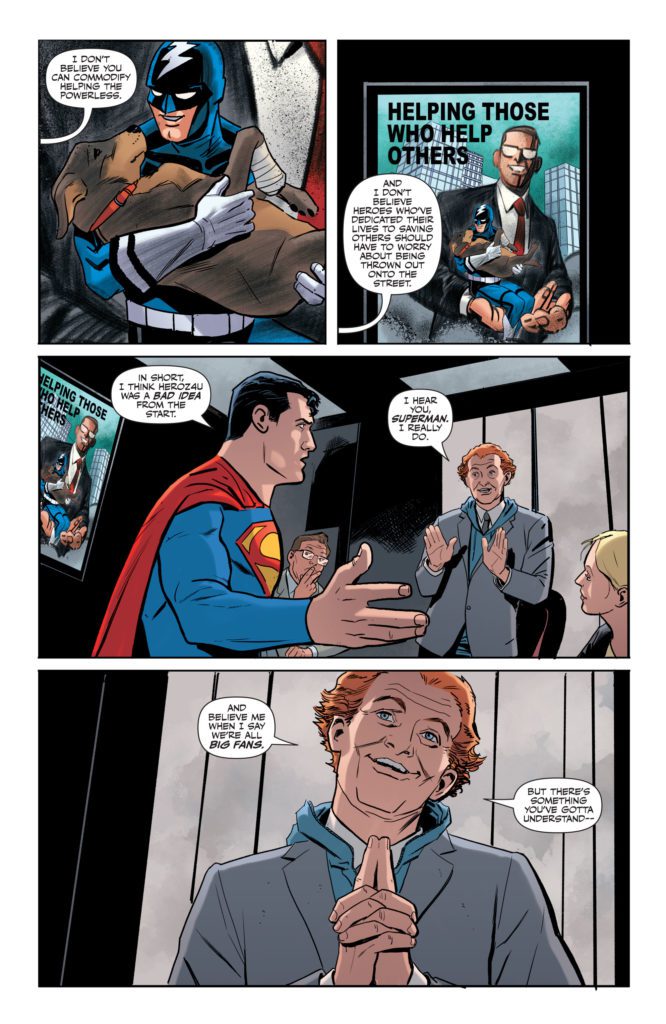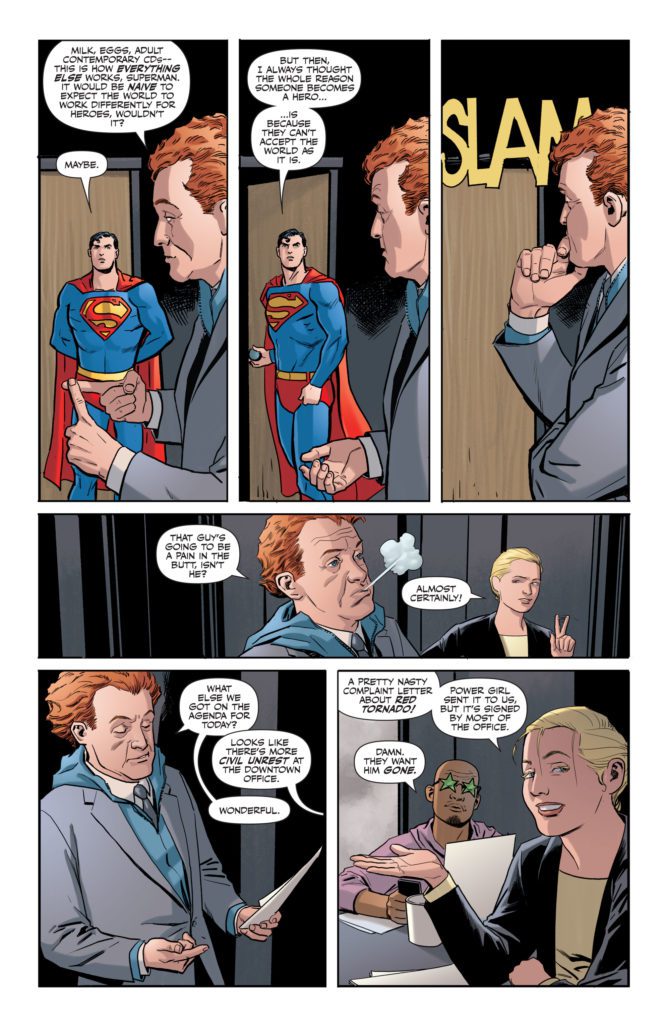One-Star Squadron is unlike any of DC Comics’ other projects. It has no villainous monologues or doomsday devices. Instead, One-Star Squadron is full of the real life weapons of our own destruction. Writer Mark Russell, artist Steve Lieber, colorist Dave Stewart, and letterer Dave Sharpe fill One-Star Squadron #3 with true villains: the puppeteers of capitalism.
Writing
I’ve read about Superman facing down Doomsday. He’s fought 5th dimensional imps and global terrorists. This is the first time I’ve seen Superman face a smarmy board of directors. And Russell immediately shows us how this fight for Superman isn’t as simple as all the others. The board of directors are polite, even jovial. Worst of all, they’re not threatened one bit. Russell shows us that these are dangerous people. The type of people that see nothing wrong with what they’re doing. They just smile and get their way. In making the villains of One-Star Squadron #3 your average corporate shark, Russell underlines the hopelessness in today’s zeitgeist. If these guys are so self-deceived they’d happily stare down the Man of Steel, what are we supposed to do?

Art
So much of the casual feeling of our villains comes from Lieber’s art. He almost convinces you to like this board of directors. They’re charismatic and charming. Hell, they’re some of the only people to smile in these pages. But that’s also what makes them sinister. Lieber, in creating an entirely different mood, in the confines of the boardroom, shows how disconnected this board is from the grief their decisions bring about. They don’t want to know. They’re blissfully unaware. Every other character, under Lieber’s pen, is haggard and depressed. Red Tornado agonizes over how to keep his staff afloat, while they sneer at him with contempt. In previous issues, the melodrama of a character’s body language was often used comedically. But now, Lieber has seamlessly moved into the realm of heartbreak. The deeply expressive faces of these characters, juxtaposed against the toothy grins of the corporate elite, will make you want to cry.
Coloring
There’s a similar disconnect in Stewart’s coloring. The bright colors of superhero costumes, often symbols of hope, hang around the frames of disillusioned has-beens. And while these characters are shown in vibrant uniforms, their surroundings are grey and dull. Their costumes are an extension of the brave face they’re trying to put on. Meanwhile, the board of directors in their black turtlenecks, grey suits, and faded blue hoodies are brimming with joy. They have learned to blend in with their surroundings. They’ve figured out how the world works, and how to make it bend to their will.

Lettering
Sharpe uses the spacing between word balloons to convey hesitation or confidence. When we open on the board of directors, Sharpe immediately shows us what a confident group of people this is. Their dialogue seems rehearsed, perfectly scripted. Their word balloons bump up against each other. There’s no air between each thing they’re saying, they’re ready to jump into the conversation the moment their colleague is finished with their “line.” They then ask Superman a rhetorical question. “It would be naïve to expect the world to work differently for heroes, wouldn’t it?” There’s a big gap between that line and Superman’s response: “Maybe.” Sharpe pulls you into every scene. The visual rhythm he creates tells us everything we need to know about the power dynamics at play.
DC Comics’ One-Star Squadron seamlessly moves from the hilarious to the flat-out sad. Russell, Lieber, Stewart, and Sharpe are creating an indictment of our throwaway culture. They lure us in with plenty of laughs, before giving us a poignant punch to the gut. I, for one, can’t wait to see where it takes us next. Pick up the stunning One-Star Squadron #3, out from DC Comics February 1st, at a comic shop near you!

